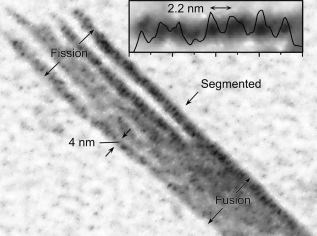Zhang, X.; Görl, D.; Stepanenko, V.; Würthner, F. Angew. Chem. Int. Ed. 2014, Early View.
DOI: 10.1002/anie.201308963
Dye aggregates are becoming increasingly attractive for diverse applications, in particular as organic electronic and sensor materials. However, the growth processes of such aggregates from molecular to small assemblies up to nanostructures is still not properly understood, limiting the design of materials’ functional properties. Here we elucidate the supramolecular growth process for an outstanding class of functional dyes, perylene bisimides (PBIs), by transmission electron microscopy (TEM), cryogenic scanning electron microscopy (cryo-SEM), and atomic force microscopy (AFM). Our studies reveal a sequential growth of amphiphilic PBI dyes from nanorods into nanoribbons in water by fusion and fission processes. More intriguingly, the fluorescence observed for higher hierarchical order nanoribbons was enhanced relative to that of nanorods. Our results provide insight into the relationship between molecular, morphological, and functional properties of self-assembled organic materials
Amphiphilic perylene bisimide (PBI) dyes[1] exhibit the largest intermolecular interaction energies of all dyes, which is further enhanced in water by a pronounced hydrophobic effect. PBI aggregates raised the expectation to achieve long-range structural order beyond that achieved for other smaller and more flexible amphiphilic p-scaffolds which are packed together by weaker noncovalent interactions.
In this paper, Wüerhner and coworkers elucidate the growth process for PBI from a single-component system to small molecular assemblies up to large nanostructures by transmission electron microscopy (TEM) with resolution on the molecular level.
- References
[1] “Molecular Assemblies of Perylene Bisimide Dyes in Water”
Goerl, D.; Zhang, X.; Wuerthner, F. Angew. Chem. Int. Ed. 2012, 51, 6328–6348. DOI: 10.1002/anie.201108690
Perylene bisimides are among the most valuable functional dyes and have numerous potential applications. As a result of their chemical robustness, photostability, and outstanding optical and electronic properties, these dyes have been applied as pigments, fluorescence sensors, and n-semiconductors in organic electronics and photovoltaics. Moreover, the extended quadrupolar π system of this class of dyes has facilitated the construction of numerous supramolecular architectures with fascinating photophysical properties. However, the supramolecular approach to the formation of perylene bisimide aggregates has been restricted mostly to organic media. Pleasingly, considerable progress has been made in the last few years in developing water-soluble perylene bisimides and their application in aqueous media. This Review provides an up-to-date overview on the self-assembly of perylene bisimides through π–π interactions in aqueous media. Synthetic strategies for the preparation of water-soluble perylene bisimides and the influence of water on the π–π stacking of perylene bisimides as well as the resulting applications are discussed.
- Related Links
- Related Books
[amazonjs asin=”9814324558″ locale=”US” title=”Nanostructures and Nanomaterials: Synthesis, Properties, and Applications (2nd Edition) (World Scientific Series in Nanoscience and Nanotechnology)”]



